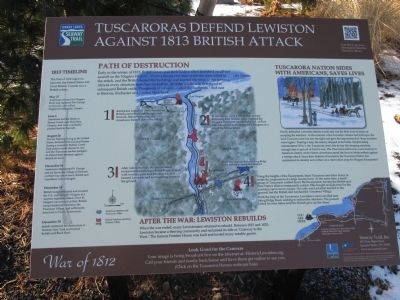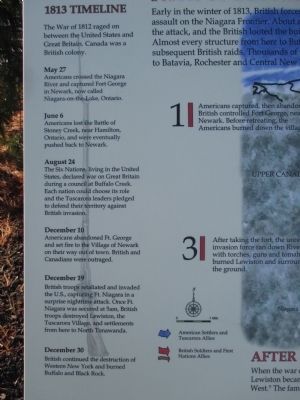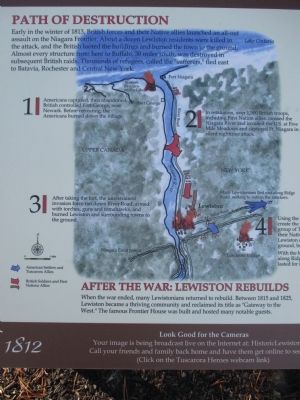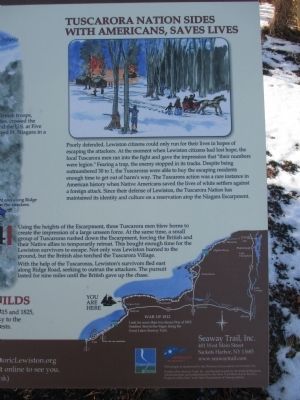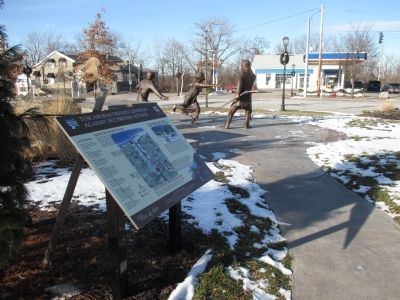Lewiston in Niagara County, New York — The American Northeast (Mid-Atlantic)
Tuscaroras Defend Lewiston Against 1813 British Attack
War of 1812
Inscription.
Path of Destruction.
Early in the winter of 1813, British forces and their Native allies launched an all-out assault on the Niagara Frontier. About a dozen Lewiston residents were killed in the attack, and the British looted the buildings and burned the town to the ground. Almost every structure from here to Buffalo, 30 miles south, was destroyed in subsequent British raids. Thousands of refugees, called the "sufferers," fled east to Batavia, Rochester, and Central New York.
Tuscarora Nation Sides with Americans, Saves Lives.
Poorly defended, Lewiston citizens could ony run for their lives in hopes of escaping the attackers. At the moment when Lewiston citizens had lost hope, the local Tuscarora men ran into the fight and gave the impression that "their numbers were legion." Fearing a trap, the enemy stopped in its tracks. Despite being outnumbered 30 to 1, the Tuscaroras were able to buy the escaping residents enough time to get out of harm's way. The Tuscarora action was a rare instance in American history when Native Americans saved the lives of white settlers against a foreign attack. Since their defence of Lewiston, the Tuscarora Nation has maintained its identity and culture on a reservation atop the Niagara Escarpment.
1 | Americans captured, then abandoned, British controlled Fort George, near Newark. Before retreating, the Americans burned down the village.
2 | In retaliation, over 1,500 British troops, including First Nations allies, crossed the Niagara River and invaded the U.S. at Five Mile Meadows and captured Ft. Niagara in a nighttime attack.
3 | After taking the fort, the unrestrained invasion force ran down River Road, armed with torches, guns and tomahawks, and burned Lewiston and surrounding towns to the ground.
4 | Using the heights of the Escarpment, three Tuscarora men blew horns to create the impression of a large unseen force. At the same time, a small group of Tuscaroras rushed down the Escarpment, forcing the British and their native allies to temporarily retreat. This bought enough time for the Lewiston survivors to escape. Not only was Lewiston burned to the ground, but the British also torched the Tuscarora Village.
With the help of the Tuscaroras, Lewiston's survivors fled east along the Ridge Road, seeking to outrun the attackers. The pursuit lasted for nine miles until the British gave up the chase.
After the War: Lewiston Rebuilds.
When the war ended, many Lewistonians returned to rebuild. Between 1815 and 1825, Lewiston became a thriving community and reclaimed its title as "Gateway to the West." The famous Frontier House was built and hosted many notable guests.
1813 Timeline.
The War of 1812 raged on between the United States and Great Britain. Canada was a British colony.
May 27- Americans crossed the Niagara River and captured Fort George in Newark, now called Niagara-on-the-Lake, Ontario
June 6- Americans lost the Battle of Stoney Creek, near Hamilton, Ontario, and were eventuallly pushed back to Newark.
August 24- The Six Nations, living in the United States, declared war on Great Britian during a council at Buffalo Creek. Each nation could choose its role and the Tuscarora leadrers pledged to defend their territory against British invasion.
December 10 - Americans abandoned Ft. George and set fire to the Village of Newark on their way out of town. British and Canadians were otraged.
December 19- British troops retaliated and invaded the U.S., capturing Ft. Niagara in a surprise nighttime attack. Once Ft. Niagara was ecured at 5am, British troops destroyed Lewiston, the Tuscarora Village, and settlements from here to North Tonawanda.
December 30- British continued the destruction of Western New York and burned Buffalo and Black Rock.
Look Good for the Cameras.
Your image is being broadcast live on the internet at: HistoricLewiston.org . Call your family and friends back home and have them get online to see you. (Click on the Tuscarora Heroes webcam link.)
Look for more than two dozen War of 1812 Outdoor Storyteller Signs along the Great Lakes Seaway Trail.
Seaway Trail, Inc. 401 West Main Street, Sackets Harbor, NY 13685, www.seawaytrail.com . America's Byways. This plaque is sponsored by the Historical Association of Lewiston, Inc. Produced by Seaway Trail, Inc. and funded in part by the Federal Highway Administration and administered by the New York State Scenic Byways Program of the New York State Department of Transportation.
Erected by Seaway Trail, Inc.
Topics and series. This memorial is listed in these topic lists: Native Americans • War of 1812. In addition, it is included in the Great Lakes Seaway Trail National Scenic Byway series list. A significant historical date for this entry is December 13, 1813.
Location. 43° 10.334′ N, 79° 2.076′ W. Marker is in Lewiston, New York, in Niagara County. Memorial is at the intersection of Portage Road and Center Street (New York State Route 18F), on the right when traveling south on Portage Road. Touch for map. Marker is in this post office area: Lewiston NY 14092, United States of America. Touch for directions.
Other nearby markers. At least 8 other markers are within walking distance of this marker. Tuscarora Heroes Monument (within shouting distance of this marker); Rare M1890 3.6 Inch Mortar Cannon (within shouting distance of this marker); Dedicated to the Men and Women (within shouting distance of this marker); Site of Hustler's Tavern (about 300 feet away, measured in a direct line); Suspension Bridge Tollhouse (about 600 feet away); Lewiston Academy (about 600 feet away); Opera Hall (approx. 0.2 miles away); Hennepin Hall (approx. ¼ mile away). Touch for a list and map of all markers in Lewiston.
Also see . . .
1. Historic Lewiston. Web site with webcam link as on the marker. (Submitted on January 27, 2015, by Anton Schwarzmueller of Wilson, New York.)
2. Capture of Fort Niagara - Wikipedia. (Submitted on January 27, 2015, by Anton Schwarzmueller of Wilson, New York.)
Credits. This page was last revised on May 2, 2021. It was originally submitted on January 27, 2015, by Anton Schwarzmueller of Wilson, New York. This page has been viewed 903 times since then and 43 times this year. Photos: 1, 2, 3, 4, 5. submitted on January 27, 2015, by Anton Schwarzmueller of Wilson, New York.
